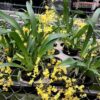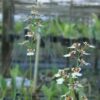# Protecting Dancing Lady Orchids (*Oncidium*) from Insects: Essential Tips and Strategies

Dancing Lady Orchids, scientifically known as *Oncidium*, are beloved for their vibrant, unique flowers and intricate shapes. However, like all plants, they can be susceptible to various pests that can damage or even destroy their beauty. To keep your *Oncidium* orchids thriving, it is essential to understand how to effectively protect them from insect infestations. This comprehensive guide will provide you with practical strategies, preventive measures, and treatment options to ensure your Dancing Lady Orchids remain healthy and beautiful.
## 1. Understanding Common Insect Pests
### 1.1 Types of Insect Pests
Before implementing protective measures, it’s crucial to identify the common pests that affect *Oncidium* orchids. Each type of pest requires different approaches for control.
– **Aphids**: Small, soft-bodied insects that suck the sap from plants, leading to wilting and stunted growth. They are often green, black, or yellow.
– **Mealybugs**: White, cotton-like pests that cluster in the leaf axils and on the stems. They excrete a sticky substance known as honeydew, which can lead to sooty mold.
– **Spider Mites**: Tiny, spider-like creatures that thrive in dry conditions. They create fine webbing on plants and cause leaves to become stippled and yellowed.
– **Scale Insects**: Small, armored pests that attach themselves to stems and leaves, feeding on plant sap and causing yellowing and leaf drop.
– **Thrips**: Tiny, slender insects that can cause significant damage to flowers and leaves, leaving silvery streaks and speckles.
### 1.2 Recognizing Signs of Infestation
Identifying an infestation early is key to managing it effectively. Look for the following signs:
– **Discolored Leaves**: Yellowing, wilting, or browning leaves can indicate insect damage.
– **Sticky Residue**: A sticky substance on leaves or around the plant may suggest a mealybug or aphid infestation.
– **Webbing**: Fine webs between leaves are a clear sign of spider mites.
– **Visible Pests**: Look closely at the undersides of leaves and along stems for signs of pests.
## 2. Preventive Measures to Protect Your Orchids
### 2.1 Maintaining Proper Cultural Practices
Preventing insect infestations begins with good cultural practices that promote plant health.
#### 2.1.1 Optimal Watering Practices
Overwatering or underwatering can weaken your orchids and make them more susceptible to pests. Here are some tips:
– Water when the top inch of the potting medium feels dry.
– Ensure proper drainage to avoid stagnant water, which can lead to root rot and make plants more vulnerable to pests.
#### 2.1.2 Appropriate Lighting Conditions
*Oncidium* orchids thrive in bright, indirect light. Too much direct sunlight can stress plants, while insufficient light can weaken them.
– Place your orchids near a window that provides filtered sunlight.
– Rotate your plants periodically to ensure even light exposure.
#### 2.1.3 Humidity and Temperature Control
Maintaining ideal humidity (50%-70%) and temperature (65°F to 80°F) helps keep your *Oncidium* healthy.
– Use a humidity tray or mist your plants regularly.
– Avoid placing your orchids near drafts, heaters, or air conditioning vents that can cause temperature fluctuations.
### 2.2 Quarantine New Plants
Before introducing new orchids to your collection, quarantine them for at least two weeks. This practice allows you to monitor for any pests or diseases that could spread to your existing plants.
– Inspect new plants thoroughly for any signs of infestation.
– Keep them in a separate area until you are sure they are pest-free.
### 2.3 Cleaning and Maintenance
Regular cleaning and maintenance can help prevent pest problems before they start.
#### 2.3.1 Cleaning Leaves
Dust and debris on leaves can attract pests. Wipe down leaves with a damp cloth every few weeks to keep them clean.
– Use lukewarm water mixed with a few drops of mild soap for cleaning.
– Be gentle to avoid damaging the delicate leaves.
#### 2.3.2 Pruning and Removing Debris
Regularly check your orchids for dead or decaying leaves and flowers, and prune them away to reduce hiding places for pests.
– Dispose of any cuttings and debris promptly to prevent pest attraction.
– Keep the area around your orchids tidy to minimize pest habitats.
## 3. Natural and Organic Pest Control Methods
If pests do appear, many natural and organic control methods can effectively manage them without harsh chemicals.
### 3.1 Insecticidal Soap
Insecticidal soap is a safe and effective treatment for many soft-bodied pests, including aphids, mealybugs, and spider mites.
– Mix 2-3 tablespoons of liquid soap (not detergent) with a quart of water in a spray bottle.
– Spray directly onto affected plants, covering all surfaces, especially the undersides of leaves.
### 3.2 Neem Oil
Neem oil is a natural pesticide derived from the seeds of the neem tree. It is effective against various pests and has antifungal properties.
– Dilute 2 tablespoons of neem oil in a quart of water and add a few drops of liquid soap.
– Spray the mixture onto your orchids, ensuring thorough coverage.
### 3.3 Diatomaceous Earth
Diatomaceous earth (DE) is a non-toxic powder made from fossilized algae that can deter crawling insects like ants and soft-bodied pests.
– Sprinkle a thin layer of food-grade DE on the soil surface and around the base of your orchids.
– Ensure the powder is dry, as moisture reduces its effectiveness.
### 3.4 Essential Oils
Certain essential oils, like peppermint and lavender, can repel pests.
– Mix a few drops of essential oil with water in a spray bottle.
– Lightly mist the plants and surrounding area to deter insects.
## 4. Chemical Pest Control Options
In some cases, natural methods may not suffice, and chemical treatments may be necessary. Always opt for the least toxic options available.
### 4.1 Systemic Insecticides
Systemic insecticides are absorbed by the plant and can provide long-lasting protection against pests.
– Use systemic insecticides specifically formulated for orchids, following the manufacturer’s instructions.
– Apply these treatments carefully, avoiding excessive use that could harm beneficial insects.
### 4.2 Contact Insecticides
Contact insecticides work by killing pests on contact. These can be effective but should be used with caution.
– Apply contact insecticides in the evening or early morning when pollinators are less active.
– Follow label instructions and avoid spraying in direct sunlight to prevent plant damage.
## 5. Regular Monitoring and Inspection
### 5.1 Scheduled Check-Ups
Make it a habit to regularly check your *Oncidium* orchids for any signs of pests or disease. Establish a schedule, perhaps weekly or biweekly, to inspect your plants thoroughly.
– Check both the tops and undersides of leaves.
– Look for any signs of damage or pest activity.
### 5.2 Observing Plant Health
Monitor the overall health of your orchids. Any changes in growth patterns, leaf color, or flower production may indicate a pest problem.
– Keep a journal to track your orchids’ growth and any treatments applied.
– Document any pest sightings or changes to help identify recurring issues.
## 6. Dealing with Severe Infestations
If you discover a severe infestation that cannot be managed with home remedies or preventive measures, consider the following steps:
### 6.1 Isolation
Immediately isolate the affected plants to prevent pests from spreading to your healthy orchids. Place them in a separate area until the infestation is under control.
### 6.2 Intensive Treatment
– **Prune**: Remove heavily infested leaves or flowers to reduce pest populations.
– **Apply Treatments**: Use stronger insecticides or a combination of treatments if necessary, always following safety guidelines.
### 6.3 Evaluate Environmental Conditions
Assess whether any environmental factors may be contributing to the infestation, such as low humidity or high temperature fluctuations.
– Adjust your care routine as needed to promote healthier plants.
## 7. Encouraging Beneficial Insects
### 7.1 Introducing Predatory Insects
Encouraging beneficial insects can help keep pest populations in check. Consider introducing predatory insects that feed on common pests.
– **Ladybugs**: Effective against aphids and mealybugs.
– **Lacewings**: Target aphids, thrips, and other soft-bodied pests.
### 7.2 Creating a Friendly Environment
To attract beneficial insects, create an environment that supports their presence.
– Plant companion plants nearby that attract beneficial insects, such as marigolds, yarrow, or dill.
– Avoid using broad-spectrum pesticides that can harm beneficial insects.
## 8. Seasonal Considerations
### 8.1 Spring and Summer Care
During the growing season, *Oncidium* orchids may be more susceptible to pests due to increased warmth and humidity.
– Increase monitoring during these seasons and implement preventive measures.
– Ensure proper watering and humidity levels to keep plants healthy.
### 8.2 Fall and Winter Care
Pest activity may decrease during colder months, but indoor conditions can create environments conducive to pests.
– Maintain good air circulation and humidity levels to prevent pest resurgence.
– Monitor regularly, as indoor pests can thrive in heated spaces.
## 9. Conclusion
Protecting your Dancing Lady Orchids (*Oncidium*) from insect pests requires a proactive approach that combines preventive measures, natural control methods, and diligent monitoring. By understanding the common pests that threaten your orchids and employing effective strategies to manage and mitigate infestations, you can enjoy the beauty of your *Oncidium* without the stress of pest-related issues.
With patience and care, your orchids will flourish, providing you with stunning blooms and a sense of accomplishment as you cultivate these extraordinary plants. Remember, the key to a successful orchid garden lies in maintaining a balanced environment that promotes plant health and deters pests. Happy gardening!

